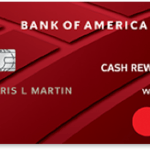The Most Dangerous Bank Card
What do I consider the most dangerous bank card? No, it’s not a credit card with an extremely high credit limit that’ll let you go crazy buying that new 60” 4K TV with the accompanying Blu-ray player and surround sound system. It’s the very basic, yet possibly very costly, debit card.
Debit cards offer the speed and convenience of accessing your money just about anywhere that accepts credit cards, but without the worry of accruing balances and high finance charges often associated with credit cards. That’s not to say debit cards don’t come with their own pitfalls, because they do, and that’s why I call them the most dangerous bank cards.
A debit card payment is just like writing a check. When you swipe your debit card at the grocery store, paying for $70 worth of groceries, that $70 is immediately taken from the bank account to which the debit card is connected – usually a checking account. The problem with debit cards is that it is too easy to swipe and not remember to record the amount you’ve deducted from your bank account. When you write a check, the paper and the written amount being deducted is right in front of you, making it easy to then enter into your check registry so that you can see what the deduction does to your overall balance. With the debit card swipe, you might have a general idea of your balance, but unless you immediately write the transaction into your bank registry – in your checkbook or via an online accounting system – it’s way too easy to forget, and there goes an accurate accounting of your bank account balance.
You should always have an accurate accounting of how much money is currently in your bank account. The main reason – it just makes good financial sense to know exactly how much money you have at all times. The most basic aspect of budgeting is providing a financial roadmap so that you don’t spend more money than you actually have. And that is where a debit card can get you into trouble.
Let’s say the day before you went to the grocery store and bought $70 worth of groceries you had an unexpected car repair for which you also used your debit card to pay. While you had plenty of money in your bank account before the car repair bill jumped up and bit you, the cost of the repair significantly reduced the money in your bank account. Remember, as soon as the debit card is swiped, the money from your account is gone. So, rather than having a cushion in your bank account, you actually had just $50 after you used the debit card to pay for the repair. Oh, and because you were so flustered by the unexpected repair and its cost, you forgot to enter it into your check registry. Then comes the next day and your grocery shopping bill of $70. Without knowing your true balance, you think there’s plenty of money in my account to cover $70 of groceries, when in fact there’s only $50 in your account. What happens? The bank takes the $70 out, leaving you in the hole for $20 AND then charges you an overdraft fee.
While the fee varies depending on your bank, expect a charge in the range of $30 for each time you overdraw your account. And while you might think the banks are fine with continually charging $30 each time an account is overdrawn, they usually aren’t, and continuous overdraft fees can negatively affect your relationship with the bank. Not to mention your bank account balance.
Fees for actually using your debit card and charges for using your debit card to get cash from out-of-network ATMs are another aspect of debit cards of which you need to be aware. Some banks charge a small fee when you use your debit card to make a purchase – such as the grocery store example – by inputting your Personal Identification Number (PIN). If your bank has this policy, then you must remember to deduct not only how much you spent for your purchase, but also the fee amount from your account balance. Not deducting the fees can get you into as much trouble as not remembering to deduct a purchase amount. The same goes for ATM fee amounts. Each time you get charged a fee for using an ATM, you have to deduct that amount from your bank account balance.
Using a debit card, in theory, makes purchasing items easier. However, if you don’t closely track your bank account balance and diligently record each and every transaction – fees included – that ease of use could quickly turn into a financial nightmare.
image courtesy of stockimages at freedigitalphotos.net



